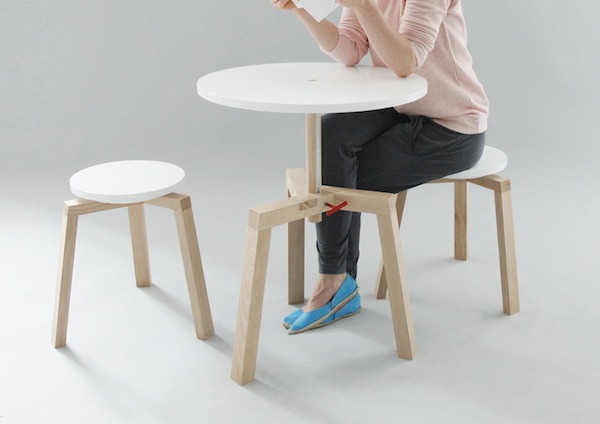
The Takka table by Agnieszka Mazur reminds me of a piano stool I had when I was little. The principle here is the same – a humble butterfly screw locks the table at an adjustable height. This simple and smart construction makes the piece an ideal contender for a small urban apartment. Takka can serve as a side table or a dining table for two. The tripod-like base provides enough leg room, and the tabletop is just big enough for an intimate table setting. A great little item to have in a confined studio or dorm.
(via gblog)

Minuetto is a cool space-saving table from Milano Smart Living. The elegant and minimalist item works equally well as a console or sofa table (taking virtually no space) and as a dining table (able to sit 10 people). The transformation is done by one person and only takes a few easy moves. Just pull on one side of a console, put the removable panels in place and you’re done. I love how attractive the piece looks in both modes. The dual function only becomes obvious when you transform the table. A beautiful, clever item, can’t wait to see it in the US at some point.
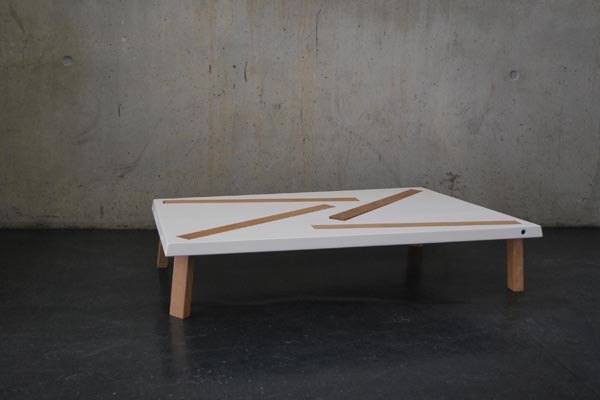
Without any reservations – this must be the most innovative hybrid I’ve seen so far. The Random coffee/dining table by Germany based designer Philipp Grundhoefer is converted into either state by pivoting the legs (see the photos after the break). The simple L shape allows for both lengths to be seamlessly interchangeable. Once the legs are pivoted – the table top can be turned upside down, the leg lock into the slots and voilà – the new function is achieved. How simple and clever! The tabletop consists of alternating layers of oak and MDF, the legs are made of oak.
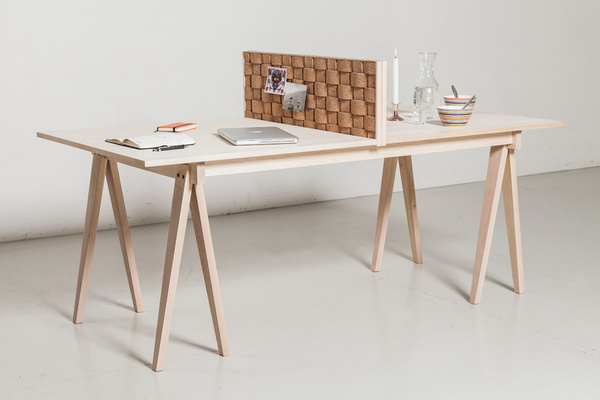
This elegant and rather witty table has been created by Reykjavík-based designer Theodóra Alfreðsdóttir. The surface of the piece is divided in two parts by a cork partition – the work area and an eating nook. On the days of big dinner parties, the partition is being removed and the proper dinner table is being set. “The inspiration for Flétta comes from medieval banquets around the 1500s, – says the designer. – At the time, halls were multifunctional and dining tables were raised upon trestles so that they could easily be put away after the feasts and the halls put to other uses. Nowadays tables are often used for more than just to sit down and eat at. Flétta can be divided in two with its middle, which is made of cork, thus creating a working space on one side and a space for enjoying dinner at the other side without having the day’s work in sight. ” The cork divider can be unfolded and used an as insert expending the tabletop even further. Beautiful idea.
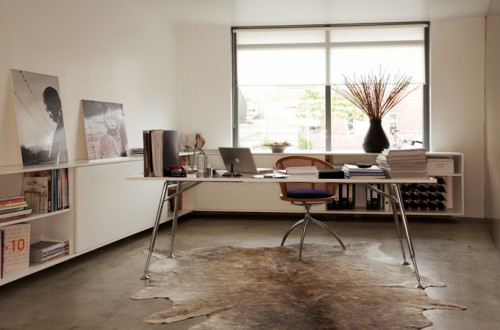
I am really impressed with this Foldable Desk from Lensvelt. The piece is a collaborative effort of two big industrial designers – Paolo Rizzatto and Franciso Gomez Paz. Created to accomodate nomad approach to the modern office, this item actually falls perfectly into the shopping list of a shoebox dweller. A sleek, minimal and easily adaptable piece, it can be used as a desk or a dining table (or both), and folded flat when an extra space is needed. And another great thing about office furniture, released into civilian life, – it usually lasts very well, for it is designed with the greater margin for abuse.
(via stilsucht)
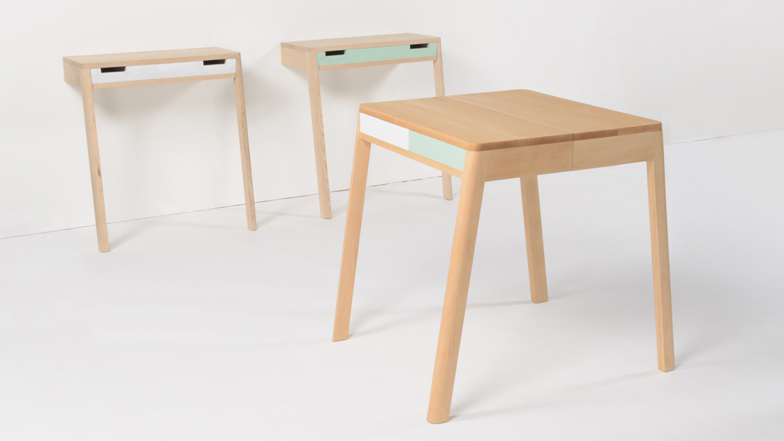
This is just delightful. The Lovebird tables by Japanese designer Yuki Matsumoto can be leant against each other to create one. Ideal for small apartments, this arrangement gives you a dining table when you need it and two small desks (or consoles) when you don’t. The most innovative feature in this design is the link between the parts. It is achieved via drawers that come out and turn 90 degrees to form a bridge between two halves. How neat is that? I also love the clean and minimal look of the pieces. The drawers come in a veriety of subtle colors that can be easily mixed and alternated.
(via dezeen)
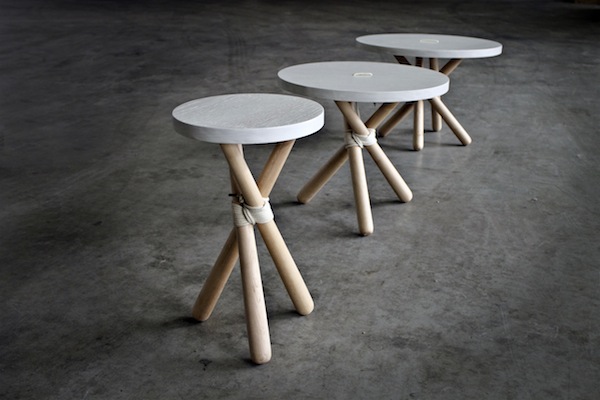
Netherlands based designer Ruben der Kinderen is the creative force behind this beautiful collection. Inspired by bushcraft (survival) techniques, these objects are assembled without screws or glue, but purely by using the forces of nature.
“I’m fascinated by survival and the things you can use in nature to make your stay comfortable,” – says Ruben. – “I went for 2 weeks to Sweden (into the wild-style) with a tent some food and my knife. By using different bushcraft techniques, to make my stay comfortable, i came to the conclusion that nothing in our own home interior has to by screwed or glued. Just by designing and making clever solutions everything can be of wood and rope.”
The system is modular. The tops of the tables are interchangeable, which provides for great flexibility. The simple and clever tripod construction is at the core of this project. At the bottom of the tabletop there is a chamber where the legs fit in. If there is a force on the tabletop the legs will spread, but as far as the walls of the chamber. Thus, the piece stays bendable and stable at the same time. A bright and elegant idea…
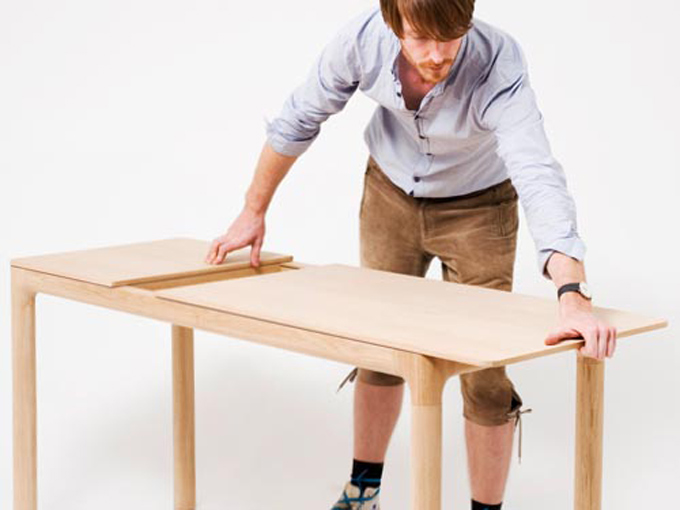
Here is another clever work/dining table hybrid. Created by Mathias Hahn for Danish brand Arco, the piece is an attempt to combine work and play on the same surface. The deed is possible thanks to a sizable sliding storage compartment that allows to put away all work-related paraphernalia during dinner time. Here is how the designer describes the concept: “The frame underneath the table top is rather slim, so there is less restriction from a thick top section that comprises a drawer unit or similar. This allowes the desk to be used more flexible when it comes to different living and work situations, however still offering the functionality of storrage within the desk.”
(via stilsucht)
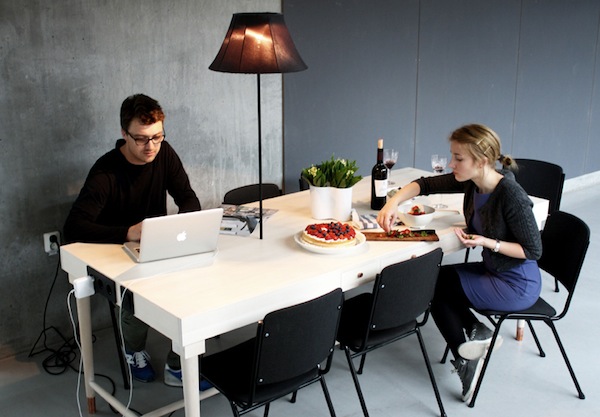
There are many tricks designers use to incorporate a full dining experience into a confined urban setting. They often make a table really compact or foldable. Designer Lisa Tischer went on a completely different quest. Her Living Table is a generously sized piece. The secret is in its adaptability to many different activities and roles. Here is how she describes it: “I see the Living Table as a platform, meeting place and workstation. It is the centre of a home and lives from being in use. It is a reluctant and unobtrusive piece of furniture but though something special and unique with many ingenious details. The Living Table is much more than just a simple dining table; it can be a workstation and a home office at the same time.” The table is equipped with a light (perfect for work or as an ambient illumination at the dinner table), several outlets for your devices or cooking electrics, and a generous number of drawers, big enough for your work papers or dining paraphernalia. Thus, by shifting the line between work, cooking and entertaining, the table can be used for all three, the heart of a home, indeed.
(via mocoloco)

This beautiful and flexible work table is a creation of Spanish designer Tomás Alonso. The piece is built to host a set of accessories – different lamps and dividers – that can be customized by the user. Here is how Alonso describes it: “The project explores the idea of the work table as a microsystem with separate elements that can be combined into an array of possibilities. An object of common use, the table is broken down into its basic components to which a series of functional accessories can then be added. The configuration of all these elements is left to the user who can arrive to their own solution in response to their own functional and aesthetic needs.” The frame itself can be individualized – the design of the aluminium profile used to secure the legs to the table allows for both aluminium and wooden legs, or a combination of both. Various colors and wooden finishes are also available.
(via fastcodesign)
